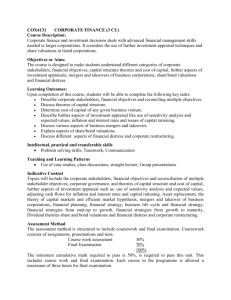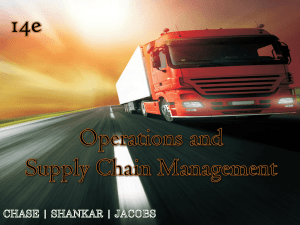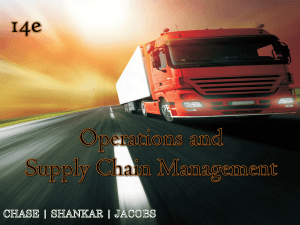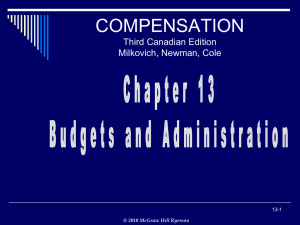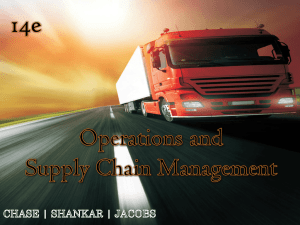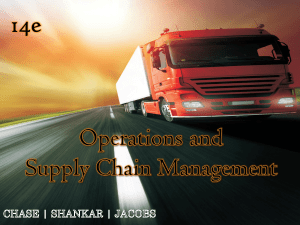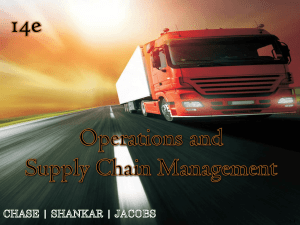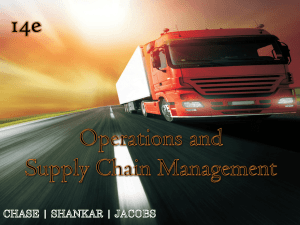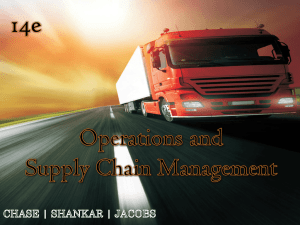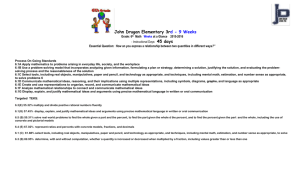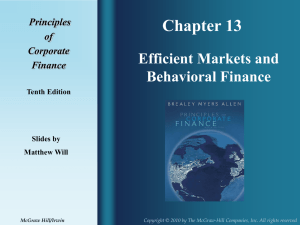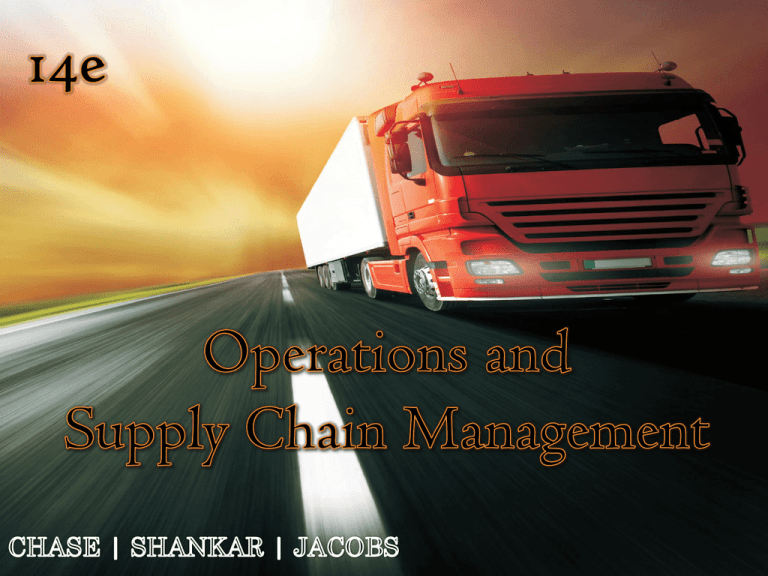
1–1
Chapter 16
McGraw-Hill/Irwin
Copyright © 2014 by The McGraw-Hill Companies, Inc. All rights reserved.
1–2
• LO16–2: Explain why companies outsource
processes.
• LO16–3: Analyze the total cost of
ownership.
Copyright © 2014 by McGraw Hill Education (India) Private Limited. All rights reserved.
• LO16–1: Explain what strategic sourcing
is.
• LO16–4: Evaluate sourcing performance.
1–3
• In the past, sourcing was another name for
purchasing.
Copyright © 2014 by McGraw Hill Education (India) Private Limited. All rights reserved.
• Strategic sourcing: the development and
management of supplier relationships to
acquire goods and services in a way that aids in
achieving the immediate needs of the business.
• As a result of globalization, sourcing implies a
more complex process suitable for products that
are strategically important.
1–4
– Commonly available products can be purchased using a
relatively simple process
• Request for proposal (RFP): used for purchasing
items that are more complex or expensive and
where there may be a number of potential vendors
• Vendor-managed inventory: when a customer
actually allows the supplier to manage an item or
group of items for them
Copyright © 2014 by McGraw Hill Education (India) Private Limited. All rights reserved.
• Specificity: refers to how common the item is and,
in a relative sense, how many substitutes might be
available
1–5
1–6
Copyright © 2014 by McGraw Hill Education (India) Private Limited. All rights reserved.
– A slight change in consumer sales ripples backward
as magnified oscillations upstream, like the result
of a flick of a bullwhip handle
• Continuous replenishment: inventory is
replaced frequently, as part of an ongoing
process
Copyright © 2014 by McGraw Hill Education (India) Private Limited. All rights reserved.
• Bullwhip effect: phenomenon of variability
magnification as we move from the customer
to the producer in the supply chain
1–7
1–8
Copyright © 2014 by McGraw Hill Education (India) Private Limited. All rights reserved.
Product life
Contribution
cycle of more
margin of 5
than two
to 20 percent
years
Only 10 to
20 product
variations
An average
forecast
error of only
10 percent
Lead time
for make-toorder
products of
from six
months to
one year
Copyright © 2014 by McGraw Hill Education (India) Private Limited. All rights reserved.
Functional products include the staples that
people buy in a wide range of retail outlets, such
as grocery stores and gas stations.
1–9
Typically these products have
a life cycle of just a few
months.
•Imitators quickly erode the
competitive advantage that innovative
products enjoy.
•Companies are forced to introduce a
steady stream of newer innovations.
Newness of the innovative
products makes demand for
them unpredictable.
The short life cycles and the
great variety typical of these
products further increase
unpredictability.
Copyright © 2014 by McGraw Hill Education (India) Private Limited. All rights reserved.
Innovation can enable a
company to achieve higher
profit margins.
1–10
1–11
Copyright © 2014 by McGraw Hill Education (India) Private Limited. All rights reserved.
Low (Functional Products)
High (Innovative
Products)
Low
(Stable Process)
Grocery, basic apparel,
food, oil, and gas
Efficient supply chain
Fashion apparel,
computers, popular music
Responsive supply chain
High
(Evolving
Process)
Hydroelectric power, some Telecom, High-end
food products
computers, semiconductor
Risk-Hedging supply chain Agile supply chain
Copyright © 2014 by McGraw Hill Education (India) Private Limited. All rights reserved.
Demand Uncertainty
1–12
Risk-hedging supply chains:
utilize strategies aimed at
pooling and sharing resources
in a supply chain to share risk.
Strategy
Responsive supply chains
utilize strategies aimed at being
responsive and flexible.
Agile supply chains utilize
strategies aimed at being
responsive and flexible to
customer needs.
Copyright © 2014 by McGraw Hill Education (India) Private Limited. All rights reserved.
Efficient supply chains utilize
strategies aimed at creating the
highest cost efficiency.
1–13
• Allows a company to create a competitive
advantage while reducing cost.
Copyright © 2014 by McGraw Hill Education (India) Private Limited. All rights reserved.
• Outsourcing: moving some of a firm’s internal
activities and decision responsibility to
outside providers.
• An entire function may be outsourced, or
some elements of an activity may be
outsourced, with the rest kept in-house.
1–14
Generate cash by selling low-return entities
Financial
Gain access to new markets, particularly in developing countries
Reduce costs through lower cost structure
Turn fixed costs into variable costs
Improve quality and productivity
Shorten cycle time
Improvement
Obtain expertise, skills, and technologies that are otherwise unavailable
Improve risk management
Improve credibility and image by associating with superior providers
Copyright © 2014 by McGraw Hill Education (India) Private Limited. All rights reserved.
Improve return on assets by reducing inventory and selling unnecessary assets
Improve effectiveness by focusing on what the firm does best
Organizational
Increase flexibility to meet changing demand for products and services
Increase product and service value by improving response to customer needs
1–15
1–16
Copyright © 2014 by McGraw Hill Education (India) Private Limited. All rights reserved.
Copyright © 2014 by McGraw Hill Education (India) Private Limited. All rights reserved.
• Being environmentally responsible has
become a business imperative.
• Many firms are looking to their supply chains
to deliver “green” results.
• Financial results can often be improved
through going green.
• A comprehensive green sourcing effort should
assess how a company uses items that are
purchased internally.
• It is also important to reduce waste.
1–17
1–18
Copyright © 2014 by McGraw Hill Education (India) Private Limited. All rights reserved.
Copyright © 2014 by McGraw Hill Education (India) Private Limited. All rights reserved.
• Total cost of ownership
(TCO): an estimate of the
cost of an item that
includes all the costs
related to the procurement
and use of an item,
including any related costs
in disposing of the item
• Can be applied to internal
costs or more broadly to
costs throughout the
supply chain
1–19
Copyright © 2014 by McGraw Hill Education (India) Private Limited. All rights reserved.
• Inventory turnover: how often
inventory is replaced during
the year
• Cost of goods sold: the annual
cost for a company to produce
the goods or services provided
to customers
• Average aggregate inventory
value: the total value of all
items held in inventory
• Weeks of supply: how many
weeks’ worth of inventory is in
the system at a particular point
in time
1–20
16-21
1–21
Copyright © 2014 by McGraw Hill Education (India) Private Limited. All rights reserved.

